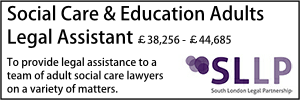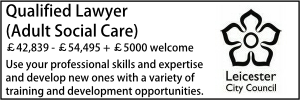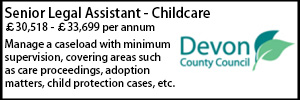The black box of the judicial visit to P
- Details
The Court of Appeal has made some very important observations about the role of judicial visits in Court of Protection cases, writes Alexander Ruck Keene.
In Re AH (Serious Medical Treatment) [2021] EWCA Civ 1768, it was asked to overturn the decision of the Vice-President, Hayden J, that it was not in the best interests of a woman, AH, to continue to receive ventilatory treatment after a short period to enable family members to travel to see AH. The decision of the Vice-President, in a case he described as involving the most complicated COVID patient in the world, is analysed here, but in summary concerned a woman who had suffered substantial neurological damage as a result of the virus, and was being cared for in a critical care unit, dependent on mechanical ventilation, continuous nursing care, nutrition and hydration delivered via a nasogastric tube, and receiving various medications.
AH’s children sought permission to appeal (through legal representatives acting pro bono). The Trust resisted their application; the Official Solicitor was initially neutral but by the time her Leading Counsel came to make submissions supported the children.
The children’s appeal was on five grounds.
The first was that Hayden J gave insufficient consideration to what was said to be AH’s earlier capacitous decision that she wished to receive “full escalation” of treatment. Moylan LJ identified that this referred to the ReSPECT form that had been completed. As he said at paragraph 43:
[…] It is a computer form which is completed by a clinician who has had, what is called, “a ReSPECT discussion” with a patient. The discussion is intended to ascertain the patient’s views as to their priorities in the event of treatment being required in an emergency, if they are unable to make or express a choice. I would note, in passing, that it is not, as set out in the judgment and some of the written submissions, a form which is “completed” by AH.
Moylan LJ agreed with Hayden J that the form did not bear the weight that the family sought to ascribe to it, holding at paragraph 46 that:
It is directed, as is clear from the title, to emergency care and treatment. It is not directed to long-term treatment and so provides very little assistance to whether AH would want treatment to continue in her current condition which is very far from an emergency (emphasis in the original).
The second was that Hayden J had failed to appreciate the overwhelming importance to AH of her religious and cultural views and the impact of those views in relation to the withdrawal of medical treatment. As Moylan LJ identifed, this was closely connected to the third ground because, in effect, it was a submission that the judge’s conclusion as to AH’s wishes and feelings, or as he described it as, what she “would want”, was flawed because he failed to give sufficient weight to AH’s religious and cultural views when determining her wishes and feelings. Moylan LJ considered that this was not sustainable, holding at paragraph 48 that:
The Judge was aware of, and took into account at [93], that “AH’s religious and cultural views are integral to her character and personality”. This was consistent with the submissions made by Ms Khalique that religion “was a central part of [AH’s] life”. The Judge clearly considered all the evidence and was entitled to conclude, at [93]:
“… I am not prepared to infer that it would follow that those views would cause her to oppose withdrawal of ventilation in these circumstances …”
I would add that the weight to be given to a particular factor is for the trial judge and not for this court.
The third ground was that Hayden J had failed adequately to consider AH’s past and present wishes and feelings. Moylan LJ dismissed this:
52. In my view it is clear, first, that the Judge did consider AH’s wishes and feelings. The contrary is not arguable because the Judge expressly considered, from [79], AH’s “likely wishes and feelings in respect of the medical options in her present circumstances”. Further, the Judge returned to this issue when considering whether the continuation of ventilation was or was not in AH’s best interests.
53. Secondly, I am not persuaded that the Judge did not “adequately” consider AH’s wishes and feelings. As referred to above, the Judge considered these between [79]-[95] and again when setting out his conclusions. What is in reality challenged is his conclusion that AH would not want ventilatory treatment to continue and, subject to ground 5, this was, in my view, a decision which the Judge was entitled to reach.
The fourth ground was that Hayden J had failed properly to balance the interference with AH’s rights under the ECHR; Moylan LJ found that the ground added nothing, the balance to be applied being clear, namely that applied by Hayden J: i.e. “whether to continue to provide ventilatory treatment is or is not in AH’s best interests” (paragraph 55).
The fifth ground related to Hayden J’s visit to see AH in hospital, which the children submitted that the visit, and what he appeared to take from it, was flawed and wholly undermined the fairness of the process and the validity of his decision. The circumstances of the visit were set out in the judgment thus:
14. From the outset of the hearing, it is plain from the transcript that the Judge was considering going to see AH in hospital. There were a number of occasions during the hearing at which it was suggested, including on behalf of the family, that the Judge should go to the hospital. However, it is also clear that at no stage was there any discussion about the purposes of any proposed visit or how, procedurally, it would fit within or affect the hearing.
15. At the conclusion of the hearing, the Judge indicated that he would visit AH in hospital. This led to a very brief exchange with one of AH’s children (A) as to whether, when the Judge visited, he would “ask her yourself”. This was because, as A explained, he had gained the impression when he had been giving his oral evidence that the Judge “felt when I asked, she was saying to please me”. This was a reference back to an exchange which had occurred during the course of A’s oral evidence.
16. It appears from the transcript that A gave evidence of his belief that his mother had shaken her head when he had asked whether she wanted to end her life. The Judge had suggested to A that the response AH gave would or might depend on how the question was phrased. The Judge commented that the answer might be different if she was asked “are you tired, do you want some peace”.
17. A few days after the end of the hearing, the Judge went to see AH in hospital. He spent some time with AH with only a nurse and a representative of the Official Solicitor present. As referred to above, a careful Note was taken by the latter. The Judge spoke to AH, who appeared to be distressed and was crying. The Judge said that he did not know what AH wanted and that “it’s very, very hard for you to tell me”. He then said, “I think it may be that you want some peace”. Later, he said: “It is not easy for you to communicate, but I think I am getting the message”.
18. The Judge then left the ward and saw two of AH’s children. A asked the Judge whether he had asked her “the question”. The Judge replied that he “got the clear impression she wanted some peace, she showed me that she did”.
On behalf of the children, it was submitted that Hayden J took into account what occurred when he visited the hospital when making his decision, in other words that:
60. He used it as “an evidence gathering exercise to establish what AH’s views were and the visit likely influenced his overall conclusion”. Mr Devereux submits that this is a reasonable inference from the Judge saying to AH, “I think maybe you want some peace” and “It is not easy for you to communicate, but I think I am getting the message”; and saying to the children at the hospital that he “got the clear impression she wanted some peace, she showed me that she did”. He submits that this resonates with the Judge’s use of the word “peace” during the hearing (as referred to in paragraph 16 above) and his conclusion in the judgment, at [107], that, “The time has come to give AH the peace which I consider she … wants”.
61. This was, he submits, procedurally unfair because AH’s children did not have an opportunity to make submissions on the Judge’s assessment of his visit. Mr Devereux acknowledges that the effect of the visit is partly speculative but submits that this is because the purpose of the visit was not determined in advance and because the Judge did not subsequently tell the parties whether, and if so how, it informed his decision.
It was further submitted that Hayden J was not equipped to draw from his visit any conclusions or insights as to what AH might want: “[t]he medical evidence shows that AH is in a “Minimally Conscious State-plus”; is unable to communicate; and has only a very limited ability to move, meaning that it is not easy to evaluate any response she might give. Dr Danbury, for example, concluded that he was not able to establish AH’s wishes” (paragraph 63).
Moylan LJ, “very regrettably,” came to the conclusion that Hayden J’s decision could not stand and must be set aside:
69. […] I say, very regrettably, because he clearly gave this case a great deal of careful consideration, as is accepted by all parties, and the description of AH’s current situation and prognosis is, indeed, bleak. But, in a case which concerns the continuation of life-sustaining treatment it is particularly important that the process leading to the decision is not procedurally flawed.
70. I agree that what happened when the Judge saw AH in hospital is capable of more than one interpretation. However, in my view, it is clearly capable of being interpreted as submitted by Mr Devereux. The language used by the Judge is capable of indicating that he did consider that AH had given him some insight into her wishes. The words, “I got the clear impression she wanted some peace, she showed me that she did” are capable of that interpretation.
71. If that is right, the Judge’s decision is undermined for two reasons. First, it is strongly arguable that the Judge was not equipped properly to gain any insight into AH’s wishes and feelings from his visit. Her complex medical situation meant that he was not qualified to make any such assessment. If the visit was used by the Judge for this purpose, the validity of that assessment might well require further evidence or, at least, further submissions.
72. Secondly, in order to ensure procedural fairness, the parties needed to be informed about this and given an opportunity to make submissions.
73. As referred to above, Miss Gollop [on behalf of the Trust] submits that any procedural unfairness did not impact on the Judge’s decision and does not make his decision unjust. The problem I have with that submission, apart from the importance of fairness, is that, although she maybe right, I am not persuaded that she is necessarily right. I consider it certainly possible that it mighthave had an effect on the Judge’s ultimate determination. Certainly, it would have had an impact on the Judge’s assessment of a key factor, namely AH’s wishes and feelings and, therefore, might have had an impact on his ultimate determination.
74. I do not, therefore, consider that the Judge’s decision can be upheld. Accordingly, I propose that permission to appeal is granted and the appeal allowed. There will need to be a rehearing which will have to take place as soon as possible.
At paragraph 75, Moylan LJ also noted that:
Finally, we were told at the hearing that some judges hearing cases involving life-sustaining treatment will often, if not frequently, visit P. Having regard to what has happened in the present case, it seems clear, as suggested by the Official Solicitor, that further consideration needs to be given as to what guidance should be given, additional to or in place of that set out in the Guidance issued by Charles J [i.e. practice guidance “Facilitating participation of ‘P’ and vulnerable persons in Court of Protection proceedings“, issued on 3 November 2016]. However, until that takes place, it is clear that the following matters should be addressed and, if possible, addressed in advance of the final hearing so that any visit can be included as appropriate within the court process. Clearly, these matters will need to be determined before any visit takes place and after hearing submissions or observations from the parties:
- Whether the judge will visit P;
- The purpose of any visit;
- When the visit is to take place and the structure of the visit (in other words, how the visit it to be managed; what is to happen during it; and whether it is to be recorded and/or a note taken);
- What is to happen after the visit. This will include, depending on the purpose of the visit, how the parties are to be informed what occurred; when and how this is to happen; and how this will fit within the hearing so as to enable it to be addressed as part of the parties’ respective cases.
In a concurring judgment, Sir Andrew McFarlane P noted that:
78. This appeal has demonstrated that it is now the practice of some, and it may be many, judges in the Court of Protection [‘CoP’] to visit the subject of the proceedings, P, when it is not possible for P otherwise to join in the proceedings. Such a practice may well be of value in an appropriate case. It is, however, important that at all stages and in every case there is clarity over the purpose of the encounter and focus on the fact that at all times the judge is acting in a judicial role in ongoing court proceedings which have yet to be concluded.
79. In the present case there was, regrettably, a lack of clarity over the purpose of the visit and the role of the Judge in undertaking it. If, as my Lords and I have accepted, it may have been the case that Hayden J was seeking to obtain some indication of AH’s wishes and feelings, then great care was needed both in the conduct of the judicial interview and the manner in which it was reported back to the parties so that a fair, open and informed process of evaluation could then be undertaken within the proceedings.
89. More generally, the light shone by this case on the apparently developing practice of judicial visits to P indicates that there is a pressing need for the CoP to develop some workable guidance for practitioners and judges in a manner similar to that which is available in the Family Court with regard to judges meeting with children who are subject to contested proceedings. Whilst the circumstances in a children case, and the reasons for any judicial encounter, may differ from those that apply in the CoP, the need for clarity of purpose and procedural fairness are likely to be the same. In recent times, the CoP has established a multi-disciplinary forum known as ‘The Hive in which matters of professional and jurisdictional importance are debated and developed. I propose to invite ‘The Hive’ urgently to consider the issue of judicial meetings with P so that a Practice Direction or Presidential Guidance on the topic may be issued. Pending such direction or guidance, I would endorse the approach described by Moylan LJ at paragraph 75 of his judgment.
Comment
The Court of Appeal were at pains in this case to make clear that this was not a case where it considered that Hayden J had necessarily reached the wrong decision as to where AH’s best interests lay. The case is therefore very different to that of AB, where the Court of Appeal found that Lieven J had reached the wrong conclusion as to whether it was in the best interests of a woman with learning disabilities to undergo a termination. And the Court of Appeal were at pains to identify that Hayden J had, in principle, adopted the right approach to evaluating AH’s best interests – including, for instance, by reference to the place of her religious beliefs.
The problem was a different one, arising out of the ‘black box’ of the judicial visit undertaken by Hayden J. The Court of Appeal was clearly troubled both about the procedural fairness of such a visit – not the principle of visiting – but the lack of clarity about what exactly the visit was for, and the lurking sense of unfairness that it gave rise to.
Whilst this case was not about capacity, it is important to identify that similar issues might well arise in this context as well. The Court of Appeal was concerned that AH’s “complex medical situation” meant that Hayden J was not qualified to gain an insight into her wishes and feelings, but there are many situations where the complexity of P’s cognitive impairments could well make it equally difficult for the judge to evaluate the person’s capacity when they are engaging with them and – in effect – matching up the expert evidence that they have heard with their impression of the person. It is to be hoped the guidance that the Court of Appeal is inviting on a pressing basis also addresses this situation.
Pending the promulgation of the guidance, the matters set out by Moylan LJ at paragraph 75 will need to be considered on each occasion a judicial visit is under consideration. More broadly, many may well find of interest the article by Dr Paula Case, When the judge met P: The rules of engagement in the Court of Protection and the parallel universe of children meeting judges in the Family Court, which, as the abstract identifies “interrogates the under-explored domain of the prevalence and forms in which ‘P’ has engaged directly with the judge (particularly by meeting with the judge without giving formal evidence) with the aid of a database of over 200 ‘health and welfare’ judgments. An integrated approach is adopted, drawing from these judgments, but also cross-referencing the far more advanced literature and case law on children meeting judges in the Family Court to explore some of the issues.”
Entirely separately, it is also helpful that Moylan LJ put to bed a persistent confusion about the ReSPECT form (which also applies to other forms of advance planning in this area) – this is a form, capturing a discussion, either with the person or those interested with their welfare if they cannot participate, recorded by the clinician and forming clinical recommendations. It is not a form completed by the person – if the person themselves wants to set down what they want to happen (or not happen), then they need to make use of such tools as advance decisions to refuse treatment or appointing a health and welfare attorney. For more on these areas, see my shedinar.
Alex Ruck Keene is a barrister at 39 Essex Chambers. This article first appeared on his Mental Capacity Law and Policy blog.























































